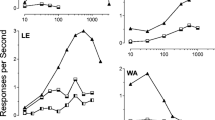Abstract
Nine human subjects were exposed to a multiple fixed-ratio (FR) differential-reinforcement-of-low-rate (DRL) schedule of monetary reinforcement. Presses on a manipulandum requiring relatively high force were occasionally followed by an increased money total displayed on a computer screen. Subjects were exposed to the schedule until their behaviour had stabilized. Prior to each of the next three sessions they were administered 0.85 g/kg alcohol. In eight of the nine subjects the initial effect of alcohol was to increase FR response rate and, consequently, reinforcement rate. Subsequent alcohol administration resulted in sensitization: even greater rate-increasing effects. In two further control sessions behaviour returned towards baseline level. DRL response rate was slightly increased by alcohol, but reinforcement rate remained unchanged. There was no consistent change in DRL response or reinforcement rates from the first to the third alcohol sessions. The effects of alcohol on human behaviour were similar to the effects found in studies with animals. The results were also consistent with the view that the changes in behaviour which occur with repeated drug administration depend in part on whether the initial effect of the drug is to increase, decrease or produce no change in reinforcement rate.
Similar content being viewed by others
References
Baron A, Galizio M (1983) Instructional control of human operant behaviour. Psychol Rec 33:495–520
Barrett JE, Stanley JA (1980) Effects of ethanol on multiple fixed-interval fixed-ratio schedule performances: Dynamic interactions at different fixed-ratio values. J Exp Anal Behav 34:185–198
Brocco MJ, McMillan DE (1983) Tolerance to d-amphetamine and lack of cross-tolerance to other drugs in rats under a multiple schedule of food presentation. J Pharmacol Exp Ther 224:34–39
Cappell H, Webster CD, Herring BS, Ginsberg R (1972) Alcohol and marijuana: A comparison of effects on a temporally controlled operant in humans. J Pharmacol Exp Ther 182:195–203
Cook L, Sepinwall J (1975) Reinforcement schedules and extrapolations to humans from animals in behavioural pharmacology. Fed Proc 34:1889–1897
Corfield-Sumner PK, Stolerman IP (1978) Behavioural tolerance. In: Blackman DE, Sanger DJ (eds) Contemporary research in behavioural pharmacology. Plenum, New York, pp 391–448
Demellweek C, Goudie AJ (1983) Behavioural tolerance to amphetamine and other psychostimulants: the case for considering behavioural mechanisms. Psychopharmacology 80:287–307
Denoble V, Begleiter H (1977) Changes in fixed-ratio performance and blood alcohol levels in monkeys. Psychopharmacology 55:213–216
Dews PB (1978) Behavioural tolerance. In: Krasnegor NA (ed) Behavioural tolerance: research and treatment implications. NIDA Res Monogr Series 18
Ferster CB, Skinner BF (1957) Schedules of reinforcement. Appleton-Century-Crofts, New York
Goldberg L (1943) Quantitative studies on alcohol tolerance in man. Acta Physiol Scand [Suppl 16] 5:1–128
Harris RA, Snell D (1980) Interactions between naltrexone and non-opiate drugs evaluated by schedule-controlled behaviour. Neuropharmacology 19:1087–1093
Harris RT, Waters W, McLendon D (1972) Behavioural effects in rhesus monkeys of repeated intravenous doses of Δ9-tetra-hydrocannabinol. Psychopharmacologia 26:297–306
Holloway FA, Vardiman DR (1971) Dose-response effects of ethanol on appetitive behaviours. Psychonom Sci 24:218–220
Holloway FA, Wansley RA (1973) Factors governing the vulnerability of DRL operant performance to the effects of ethanol. Psychopharmacologia 28:351–362
Kalant H, LeBlanc AE, Gibbins RJ (1971) Tolerance to, and dependence on, some non-opiate psychotropic drugs. Pharmacol Rev 23:135–191
Katz JL, Barrett JE (1978) Effects of ethanol on behaviour under fixed-ratio, fixed interval and multiple fixed-ratio, fixed interval schedules in the pigeon. Arch Int Pharmacodyn Ther 234:88–96
Katz JL, Barrett JE (1979) Effects of d-amphetamine and ethanol alone and in combination on schedule-controlled responding of pigeons. Psychopharmacology 64:13–18
Keppel G (1982) Design and analysis: A researcher's handbook. Prentice-Hall, New Jersey
Krasnegor NA (1978) Behavioural tolerance: research and treatment implications. NIDA Res Monogr Series 18
Kuribara H, Tadokoro S (1981) Enhancement of the avoidance-suppressing effects of neuroleptic agents after repeated administration: Changes in the discriminated avoidance response in rats. Psychopharmacology 75:148–151
Laties VG, Weiss B (1962) Effects of alcohol on timing behaviour. J Comp Physiol Psychol 55:85–91
Leander JD, McMillan DE, Ellis FW (1976) Ethanol and isopropanol effects on schedule-controlled responding. Psychopharmacology 47:157–164
Leith NJ, Kuczenski R (1981) Chronic amphetamine: tolerance and reverse tolerance reflect different behavioural actions of the drug. Pharmacol Biochem Behav 15:399–404
Lowe CF (1979) Determinants of human operant behaviour. In: Zeiler MD, Harzem P (eds) Advances in analysis of behaviour: Vol. 1 Reinforcement and the organization of behaviour. Wiley, New York, pp 159–192
Lowe CF, Beasty A, Bentall RP (1983) The role of verbal behaviour in human learning: Infant performance on fixed-interval schedules. J Exp Anal Behav 39:157–164
Matthews BA, Shimoff E, Catania C, Sagvolden T (1977) Uninstructed human responding: sensitivity to ratio and interval contingencies. J Exp Anal Behav 27:453–467
McMillan DE (1970) The effects of ethyl alcohol on temporally spaced responding in humans. J Pharmacol Exp Ther 171:159–165
Post RM (1980) Intermittent versus continuous stimulation: effect of time interval on the development of sensitization or tolerance. Life Sci 26:1275–1282
Rutschmann J, Rubinstein L (1966) Time estimation, knowledge of results and drug effects. J Psychiatr Res 4:107–114
Sanders SH, Pilley J (1973) Effects of alcohol on timing behaviour in rats. Q J Stud Alcohol 34:367–372
Schuster CR (1978) Theoretical basis of behavioural tolernce: implications of the phenomenon for problems of drug abuse. In: Krasnegor NA (ed) Behavioural tolerance: research and treatment implications. Natl Inst Drug Abuse Res Monogr Series 18:4–17
Siegel S (1983) Pharmacological habituation and learning. In: Commons ML, Herrnstein R, Wagner AR (eds) Quantitative analyses of behaviour, Volume III (Acquisition). Ballinger, Cambridge, Massachusetts
Wallgren H, Barry H (1970) Actions of alcohol. Elsevier, Amsterdam
Weiss B, Laties VG (1967) Comparative pharmacology of drugs affecting behaviour. Fed Proc 26:1146–1157
Author information
Authors and Affiliations
Rights and permissions
About this article
Cite this article
Rumbold, G.R., White, J.M. Effects of repeated alcohol administration on human operant behaviour. Psychopharmacology 92, 186–191 (1987). https://doi.org/10.1007/BF00177913
Received:
Revised:
Issue Date:
DOI: https://doi.org/10.1007/BF00177913




